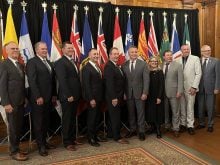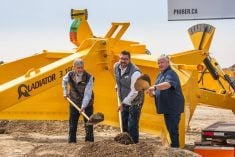Rural connectivity remains an issue for Manitobans.
That was one of the main takeaways from a recent poll commissioned by the Association of Manitoba Municipalities.
The poll, conducted by Probe Research, found that rural Manitobans are overwhelmingly concerned about mobile connectivity outside of the province’s cities.
Read Also

Seeding Indigenous agricultural prosperity
National Circle for Indigenous Agriculture and Food says Indigenous agricultural success needs strong relationships.
Why it matters: Unreliable cellular service can be a safety concern that disproportionately affects farmers in remote areas.
Only a third of rural and northern Manitobans said their cell service is completely reliable in an emergency. Just under half indicated coverage is somewhat reliable, and one in five stated their service wasn’t reliable at all.
“Reliable cell network coverage is not just about making phone calls. It’s about safety,” said AMM president Kam Blight, noting poll results speak to the larger issue of rural connectivity, including broadband service.
“That has become critical infrastructure for work, for school, for running a business, for farming,” he said. “We need to get this right.”
Rural connectivity has been on the agenda of the Keystone Agricultural Producers since 2008. That year, the organization first passed a resolution committing to lobby for enhanced cell and high-speed internet. KAP president Jill Verwey said the organization continues to advocate on those services.
“Both are very important for farming operations,” she said.
Back in 2020, when Verwey was vice-president of the organization, KAP conducted a survey that closely mirrored the findings of the AMM poll. That survey found almost two-thirds of respondents were dissatisfied with their mobile phone and internet coverage.
“Farm operations require strong internet and cell coverage to conduct business and ensure that food continues to make its way to market,” said Verwey. “We have heard deep-seated frustration from both farm families and non-farmers about the state of connectivity in rural Manitoba, and providers cannot continue to ask us to pay for a service that is subpar, at best.”
The issue also burst into the spotlight in summer 2018 following a grain elevator fire in the southern Manitoba community of Crystal City and a tornado in the northwestern community of Alonsa.
Following the twister, Alonsa residents complained that they did not get the expected weather alerts on their phones, and community officials noted local government and community services could not spread warnings due to lack of cell service.
The fire caused similar complaints. Farmers trying to organize water hauling or contact friends or family said they could not connect, text messages didn’t go through and, unlike first responders, they did not have radios.
Election 2023
Under their Let’s Grow Manitoba Together pre-election campaign, the AMM has put the spotlight on issues like rural connectivity, hoping to turn them into election issues.
The campaign included a debate in April that invited all provincial party leaders. Rural connectivity was raised by Manitoba Liberal leader Dougald Lamont during a broader discussion on infrastructure.
“We’ve all experienced bad cell service. And that’s another thing that needs to be a huge priority,” he said. “Cell service is not a luxury. It’s absolutely essential because there are farmers and others who need to contact emergency services who can’t even get a cell signal.”
The province declined to comment on the AMM poll, saying cellular service falls under federal jurisdiction.
In May, James Teitsma, Manitoba minister of consumer protection and government services, said reliable connectivity is “critically important for the safety, well-being and economic success of all Manitobans.”
He was speaking about a contract dispute between internet company Xplore and Manitoba Hydro, which had paused a project to convert surplus Manitoba Hydro fibre-optic cable to an expanded broadband network in remote areas of the province.
“We are taking action to close the telecommunications gap for rural, northern and Indigenous communities, and this work is underway,” Teitsma said.
But he also said the responsibility doesn’t fall only to the provincial government.
“There is a role for the private sector as well as government, including the federal government’s commitment to connecting 98 per cent of Canadians to high-speed Internet by 2026,” he said.
The AMM poll, which included questions about funding for municipalities and public safety, was conducted in the first two weeks of June. It reached 1,000 Manitobans, 60 per cent in Winnipeg and 40 per cent outside the perimeter. The survey results are considered to have a margin of error of 3.1 per cent, 19 times out of 20.
“It’s an election year. We thought we’d check our provincial priorities against public sentiment,” Blight said. “It turns out the issues we’ve been pressing are through the roof in the public’s mind.”
















